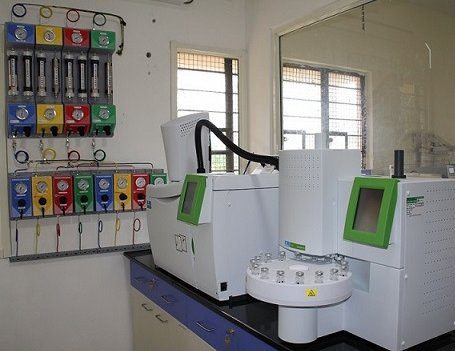Gas solid chromatography and Gas liquid chromatography are both the main types of Gas chromatography. In both methods, either liquid or solid is used as a stationary phase whereas gas is used a mobile phase.
Gas solid chromatography entails passage of a mixture of volatile compounds with differential migration through a column containing solid stationary phase like charcoal or molecular sieves. Gas solid chromatography is not widely used because of limited number of stationary phases available. In Gas solid chromatography, the principle of separation is adsorption. It is mainly used for solutes which have less solubility in stationary phases like charcoal or molecular sieves.

Gas liquid chromatography entails passage of a mixture of volatile compounds with differential migration through a column containing liquid stationary phase. Liquid chromatography can be carried out either in a column or a plane. In gas liquid chromatography, the principle of separation is only partition and therefore particles are separated according to their partition-coefficients.
Liquid gas chromatography utilizes very small amount of particles and relatively high pressure is applied. Both solute and solvents are attached to the polar sides on stationary phase.

Also Read: Difference Between Paper, Thin-Layer And Column Chromatography
The Difference Between Gas Solid And Gas Liquid Chromatography In Tabular Form
| BASIS OF COMPARISON | GAS SOLID CHROMATOGRAPHY (GSC) | GAS LIQUID CHROMATOGRAPHY (GLC) |
| Description | Gas solid chromatography entails passage of a mixture of volatile compounds with differential migration through a column containing solid stationary phase. | Gas liquid chromatography entails passage of a mixture of volatile compounds with differential migration through a column containing liquid stationary phase. |
| Columns | Gas solid chromatography uses packed columns. | Gas liquid chromatography uses capillary columns. |
| Description Of the Technique | Gas solid chromatography is an adsorption chromatography technique. | Gas liquid chromatography is a partition chromatography technique. |
| Retention Time | In gas solid chromatography, the retention time (Rf) is relatively long when compared to that of GLC. | In Gas liquid chromatography, the retention time (Rf) is relatively short when compared to that of GSC. |
| Sample Concentration | Relatively very small concentrations of the samples can be used in Gas solid chromatography. | Relatively higher concentration of samples can be used in gas liquid chromatography. |
| Stationary Phase | The stationary phase used in gas solid chromatography is in solid state. | The stationary phase used in gas liquid chromatography is in liquid state. |
| Distribution Coefficient of Compounds | In gas solid chromatography, the distribution coefficient of compounds is relatively much large. | In gas liquid chromatography, the distribution coefficient of compounds is relatively much smaller. |
Similarities Between Gas solid chromatography and Gas liquid chromatography
- Both GSC and GLC uses a gaseous phase of inert gas
- Both GSC and GLC are extensively used in separation of volatile compounds/mixtures.
- Both GLC and GSC use same type of detectors.
- In both techniques, heat labile compounds cannot be separated.
Application of Gas Chromatography
Gas chromatography is widely used for the separation and analysis of mixtures of many compounds at very low concentrations. The main areas of application of Gas chromatography are:
- Analysis of toxic compounds
- Analysis of Solvents
- Analysis of hydrocarbons
- Forensic fields
- Pollution studies
- Environmental studies